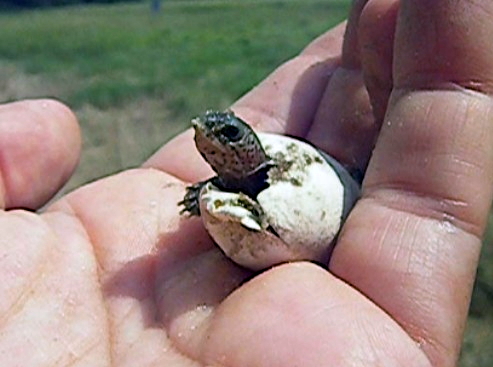(Click here to see story in Cape Cod Times On-Line.)
They’re back. And this year they’re early. This summer’s heat wave has baked the diamondback terrapin eggs buried underneath local beaches to the point the minuscule turtles are hatching earlier than at any point in the past three decades, said Don Lewis, executive director of the Massachusetts Association of Conservation Districts. Terrapin eggs on Lieutenant Island in Wellfleet began hatching Friday, after being laid in a nest on June 5, Lewis said. The eggs’ 61-day incubation period is nine days shorter than any recorded in the past 31 years, Lewis said. Terrapins hatched after 69 days in Eastham, which is still five days fewer than an average incubation period, Lewis said. Although Lewis said the early hatching is “not negative,” the turtles have been without much-needed moisture, which they absorb and use to grow while incubating. “The fact that it’s been a dry summer means a lot of the eggs are not getting enough moisture and the babies are going to be smaller than normal, which increases their vulnerability,” Lewis said. The newly hatched terrapins are roughly 1-inch long, weighing in at just one-quarter of an ounce when they hatch. That means the turtles, which are listed as threatened on the federal Endangered Species List, are susceptible to a plethora of predators. On average, each nest contains about a dozen eggs, but often only nine or 10 hatch, Lewis said. As a whole, the survival rate drops to about one of every 250 baby terrapins, he said. Although common predators such as raccoons, skunks and foxes use the protein-rich turtles to feed their own young, the turtles are also vulnerable to human beings who often don’t realize they are killing the terrapins. Lewis urged all beachgoers to look for “crawling pebbles” while traversing the Cape’s sandy shorelines for the rest of the summer, and to carry the baby turtles to safety if possible. “Just doing that little thing has an enormous conservation value because those few feet from nest to scrambling into vegetation are the most dangerous moments in that animal’s life,” Lewis said. “Saving a couple of turtles here or there makes an enormous difference to the population.” Lewis said Wellfleet Bay is one of New England’s major hot spots for terrapins, and anyone with questions about the turtles can call Lewis’ 24-hour hotline at 508-274-5108. Â =======================================
ORIGINAL PRESS RELEASE:
(Text Only, Pictures Excluded; See Turtle Journal Story Below for Photos)
New Life Emerges, Hope Returns with First 2010 Hatchlings
Long, hot summers produce happy Cape visitors and relaxed Cape residents with fond memories of warm sands, blue skies and even bluer waters. Yet, behind the scenes and under the surface, invisible to the vacationing world above, Mother Nature has been baking its own summer surprise. With an unseasonably warm spring that seduced critters into early mating and nesting, coupled with searing summer temperatures that toasted sandy shorelines under which turtle eggs were buried, the first diamondback terrapin hatchlings emerged Friday on Outer Cape Cod.
